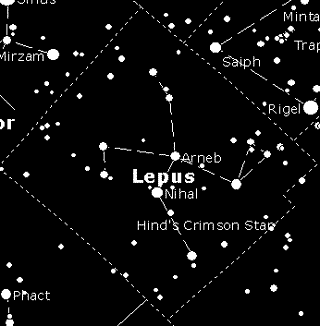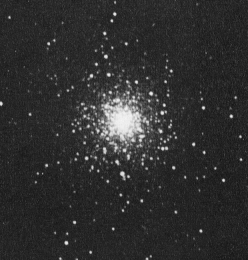
Lepus
Abbreviation: Lep
Genitive: Leopris
Right Ascension: 5.58 hours
Declination: -19.32 degrees
Lepus, the Hare is located just below Orion and west of Cannis (Major and Minor). The mythology of Lepus has been lost, but it was known to the Greeks, it is commonly believed to be the prey of Orion. This begs the question why such a formidible hunter would bother with a rabbit? Lepus sets as Corvus is rising and this could be of some significance. Ancient coins of the Chinese and Greeks, cylinders from Egypt and agate seals from Syria show an eagle battling a hare. The would however, point more to a significance with Aquila.
One of the more significant stars in Lepus was discovered in 1845 by J.R. Hind called the Hind's Crimson Star, which he described as a drop of blood on a black field. The star is a variable, ranging from 6 to 8.5 magnitudes, placing within range of modest telescopes and binoculars.
Best Known Stars
(Yale Bright Star Catalog)| Common Name or Bayer Number 1 |
RA | DEC | Magnitude 2 |
|---|---|---|---|
| ARNEB | 5.00:32.00:43.80 | -17.00:49.00:20.26 | 2.58 |
| NIHAL | 5.00:28.00:14.72 | -20.00:45.00:34.09 | 2.84 |
| EPS LEP | 5.00:5.00:27.66 | -22.00:22.00:15.80 | 3.19 |
| MU LEP | 5.00:12.00:55.88 | -16.00:12.00:19.97 | 3.31 |
| ZET LEP | 5.00:46.00:57.33 | -14.00:49.00:19.12 | 3.55 |
| GAM LEP | 5.00:44.00:27.78 | -22.00:26.00:54.31 | 3.60 |
| ETA LEP | 5.00:56.00:24.28 | -14.00:10.00:3.87 | 3.71 |
| DEL LEP | 5.00:51.00:19.28 | -20.00:52.00:44.89 | 3.81 |
| LAM LEP | 5.00:19.00:34.51 | -13.00:10.00:36.47 | 4.29 |
Deep Sky Objects
(PAS Catalog)
M-79
Other Deep Sky Objects
(Saguaro Astronomy Club Catalog)| Object | R.A. | Dec. | Object Type 3 | Mag. | Uranometria | Tirion |
|---|---|---|---|---|---|---|
| NGC 1904 | 05 24.5 | -24 33 | GLOCL | 08.4 | 315 | 19 |
Variable Stars
(General Catalog of Variable Stars)| GCVS ID | R.A. (hh mm ss.ss) |
Dec. (deg mm ss) |
Variable Type 4 | Mag. Min | Mag. Max |
|---|---|---|---|---|---|
| S Lep | 6.00:3.00:41.90 | -24.00:11.00:23.00 | SRB | 7.58 | 6.00 |
| RX Lep | 5.00:9.00:2.70 | -11.00:54.00:36.00 | SRB | 7.40 | 5.00 |
| SS Lep | 6.00:2.00:45.20 | -16.00:28.00:47.00 | ZAND | 5.06 | 4.82 |
| SZ Lep | 5.00:33.00:46.00 | -25.00:46.00:9.00 | LB: | 7.93 | 7.40 |
| TU Lep | 5.00:4.00:5.40 | -14.00:45.00:45.00 | ACV | 0.10 | 7.07 |
| TW Lep | 5.00:38.00:30.50 | -20.00:19.00:24.00 | RS: | 0.32 | 7.00 |
| TX Lep | 5.00:17.00:6.60 | -18.00:33.00:37.00 | ACV | 0.04 | 6.54 |
| UU Lep | 5.00:12.00:28.90 | -26.00:15.00:50.00 | RS | 7.02 | 6.91 |
| UV Lep | 6.00:9.00:6.90 | -15.00:46.00:49.00 | ACVO | 0.01 | 6.77 |
| mu Lep | 5.00:10.00:41.00 | -16.00:15.00:48.00 | ACV | 3.41 | 2.97 |
Double Stars
(Saguaro Astronomy Club Catalog)| Name | R.A. (hh mm.m) |
Dec. (deg mm) |
Mag 5 | Sep 6 | PA 7 | Tirion | Uranometria |
|---|---|---|---|---|---|---|---|
| STF 661 | 05 13.2 | -12 56 | 4.5, 7.4 | 2.30 | 357 | 11 | 270 |
| S 476 | 05 19.3 | -18 30 | 6.2, 6.4 | 39.30 | 18 | 11 | 270/ 315 |
| HJ 3752 | 05 21.8 | -24 46 | 5.5, 6.7 | 3.50 | 94 | 19 | 315 |
| BU 320 | 05 28.3 | -20 45 | 3.0, 7.5 | 2.30 | 346 | 11 | 315 |
| H 40 | 05 44.5 | -22 26 | 3.8, 6.4 | 96.70 | 350 | 19 | 316 |